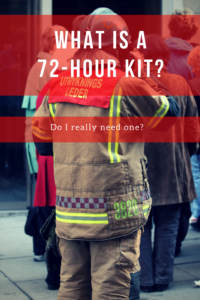
A 72-hour kit is one of the most important things you can spend money on, and provide your family. This is a kit that is used the first 3 days after a major crisis or emergency. You take this kit with you when there is a major threat making you leave your home.
But won’t the government and relief workers come to my aid?
No. It won’t. According to Homeland Security “It is estimated after a major disaster, it may take up to three days for relief workers to reach some areas.” In fact, they actually recommend having enough supplies for 7-10 days for those who are in a disaster-prone area.
Take this Emergency Kit mini-class NOW and be better prepared for tomorrow
What is a 72-hour kit?
Like mentioned above, this is a kit used in the first 3 days after an emergency. What it includes is:
- At least enough food AND water for one person for one day.
- Clothing, and a way to stay out of the elements.
- Personal identification and documents Learn more about an Emergency Binder Here
- Cash in small bills
- Light source
- Shelter
- Fire and/or heat source
- Map of the area
- Everything stored in an easily accessible portable container. One for each person in your family.
This is just a general list of suggestions for your 72-hour kit. Print out your FREE 72-hour kit checklist to help guide you through making the right decisions for your family, about what you should pack.
Why do You need it?
The obvious reason, in case an emergency. If you are told you need to evacuate your home in 5 min or less, what are you going to have time to grab? Not much. But, if you have a 72-hour kit you can grab, that allows you time to get your kids and pack, and not worry about what else you forgot. Mom with a Prep gave 3 scenarios that will give you an idea of why you might need a 72 hour kit:
• Scenario #1: Leaving Houston for the oncoming Hurricane Rita, many were stuck in the stand-still traffic on the highways going out of Houston. Some for a very long time.
• Scenario #2:Wildfires happening in the Northwest and California that have people evacuating from their homes, sometimes with only minutes to spare, and having no place to go until they can find shelter with friends and family or in governmental shelters, depending on what is available. (This is a real-life situation in California and the Northwest almost every year)
• Scenario #3: There is an explosion in the area at a local factory. The fumes might be toxic, and they cannot predict that more explosions won’t be coming. You’re asked to evacuate and make way to safer ground. But where is that? This is a real life situation for those in West, Texas in 2013 and in China in the last month.
We live in Nebraska and are prone to tornadoes. We would not need to evacuate if if a tornado was to tear through our town and demolish everything, but our 72 hour kit in our basement (where we would be for safety) will provided us with much needed items. In other words, even if you don’t live in a severe weather area, there are many other reasons you may need to leave your home (major gas leak, explosion, terrorist attack, etc).
In conclusion
Although it may take work and time to prepare your 72-hour kit, it is a great “insurance” for your family. You buy home, medical and car insurance to be safe, but hoping not to ever need it. A 72-hour kit is the same way. This your “life insurance” in an emergency, and you’ll be grateful you had it when you needed it.
How do you store your 72-hour Kit? Comment below to give other readers ideas.
72-Hour Kit Training- Make sure it’s done right with this mini class
Further Reading:
#1 Tip for Starting your 72 Hour Kit
72 Hour kit and how to build it
As always, if you love what you read or have found it helpful, please PIN, share or comment below. You can also like my Facebook page to get updates or subscribe to my email list.
Thanks for reading!

2 thoughts on “What is a 72-Hour Kit: Do I really Need One?”
This is very helpful.Thanks for sharing.
Yay, I’m so glad! Thanks for visiting!